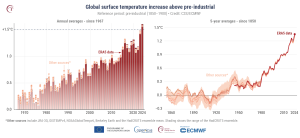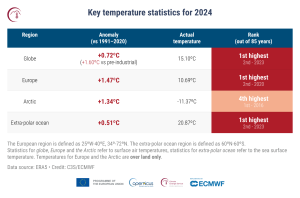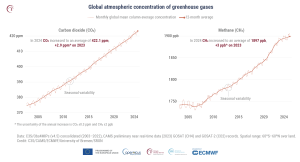2024 has officially become the warmest year on record, marking the first time in history that the global average temperature exceeded 1.5°C above pre-industrial levels.
This milestone, confirmed by the Copernicus Climate Change Service (C3S), underscores the growing impact of climate change driven by human activities, with additional contributions from natural phenomena like the El Niño Southern Oscillation (ENSO).
Scientists at the European Centre for Medium-Range Weather Forecasts (ECMWF) have been meticulously tracking global average temperature trends, and their findings reveal a year of unprecedented heatwaves, record-breaking sea surface temperatures, and alarming atmospheric changes.
Carlo Buontempo, Director of the Copernicus Climate Change Service, said: “All of the internationally produced global temperature datasets show that 2024 was the hottest year since records began in 1850.
“Humanity is in charge of its own destiny but how we respond to the climate challenge should be based on evidence. The future is in our hands – swift and decisive action can still alter the trajectory of our future climate.”
A year of record-breaking global temperatures
2024 shattered global average temperature records dating back to 1850. According to ERA5 data, the global average temperature reached 15.10°C, a 0.72°C increase above the 1991–2020 average and 0.12°C higher than the previous record set in 2023. This equates to 1.6°C above pre-industrial levels (1850–1900).
The year’s heat was relentless:
- Global milestone: For the first time, the global average temperature for an entire year exceeded the 1.5°C threshold.
- Seasonal extremes: Record warmth was recorded during boreal winter (December 2023–February 2024), spring (March–May), and summer (June–August), with temperatures significantly surpassing historical averages.
- Monthly anomalies: Eleven months of 2024 exceeded 1.5°C above pre-industrial levels, with July 22 marking the highest single-day global temperature ever recorded at 17.16°C.

The data cements 2024 as the pinnacle of a decade-long warming trend, with each year from 2015 to 2024 ranked among the ten warmest on record.
Sea surface temperatures hit new highs
Global oceans absorbed much of the heat in 2024, contributing to record-high sea surface temperatures (SSTs). The annual average SST across extra-polar oceans hit 20.87°C, 0.51°C above the 1991–2020 average.
- ENSO influence: An El Niño event that began in 2023 intensified SSTs into early 2024 before transitioning to more neutral conditions. Despite this, SSTs remained anomalously high throughout the year.
- Regional warmth: The North Atlantic, Indian Ocean, and Western Pacific experienced unprecedented SSTs, exacerbating extreme weather events like cyclones and heavy rainfall.
Europe: A hotspot of rising temperatures
Europe saw record-breaking warmth in 2024, with an average temperature of 10.69°C – 1.47°C above the 1991–2020 reference period. Both spring and summer were the hottest ever recorded in Europe.
This regional heat mirrored global patterns and posed significant risks, including heightened heat stress and adverse impacts on agriculture, ecosystems, and human health.
Extreme weather: A global phenomenon
High temperatures in 2024 fuelled a cascade of extreme weather events, including:
- Heat stress: Prolonged heatwaves led to an increase in heat stress, with 44% of the globe experiencing “strong” to “extreme” heat stress conditions at its peak in July.
- Floods and droughts: Amplified atmospheric water vapour (5% above the 1991–2020 average) heightened the risk of extreme rainfall events, while some regions suffered prolonged droughts, creating conditions ripe for wildfires.
- Wildfires: North and South America experienced large-scale wildfires. Notably, Canada recorded its second-highest wildfire carbon emissions on record, while Bolivia and Venezuela set new records.

Polar regions under threat
The Arctic and Antarctic witnessed dramatic changes in sea ice extent, crucial indicators of climate stability.
- Antarctic sea ice: After record-low extents in 2023, 2024 followed suit, with eight months ranking among the lowest on record.
- Arctic sea ice: Initially near average, Arctic sea ice extent dropped significantly after July, ranking fifth lowest at its annual minimum in September.
These reductions signal long-term threats to global sea levels and polar ecosystems.
Greenhouse gases: Drivers of rising temperatures
Atmospheric concentrations of carbon dioxide (CO₂) and methane (CH₄) reached all-time highs in 2024, with CO₂ levels hitting 422 ppm and methane concentrations rising to 1,897 ppb.
- Annual increases: CO₂ levels increased by 2.9 ppm, while methane concentrations grew by 3 ppb compared to 2023.
- Human activity: The surge in greenhouse gases remains a key driver of rising temperatures, amplifying climate-related risks worldwide.

Implications for the future
2024’s record-breaking global average temperature offers a stark reminder of the accelerating pace of climate change.
While breaching the 1.5°C threshold on an annual basis does not equate to surpassing the Paris Agreement’s long-term goals, it highlights the urgency of mitigation efforts.
Coordinated actions by organisations like ECMWF, NASA, NOAA, and the World Meteorological Organization emphasise the critical need for global collaboration in addressing the climate crisis.
As global temperatures continue to rise, the world must act decisively to limit greenhouse gas emissions, adapt to extreme weather, and protect vulnerable ecosystems.
The events of 2024 underline that climate change is no longer a distant threat – it is a present reality shaping our planet’s future.





